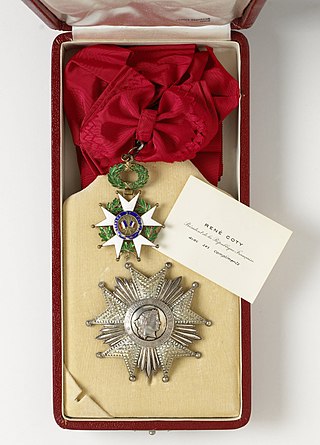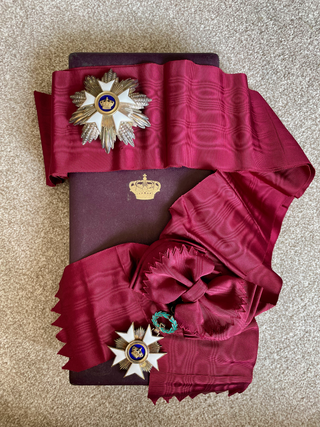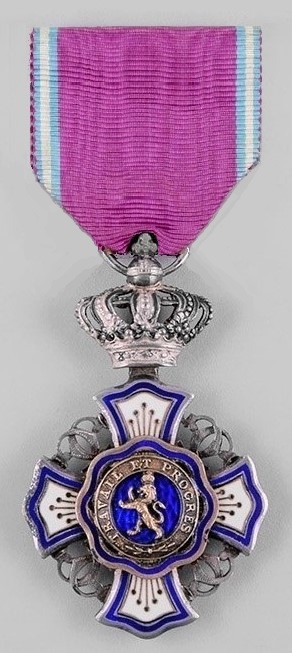This article relies largely or entirely on a single source .(March 2022) |
The Republic of Senegal awards the following orders, decorations and medals.
This article relies largely or entirely on a single source .(March 2022) |
The Republic of Senegal awards the following orders, decorations and medals.

The National Order of the Lion (French : Ordre national du Lion du Sénégal) was founded on 22 October 1960. It has a green ribbon. [1]
It has the following ranks:
The Order of Merit was founded on 22 October 1960. Its ribbon is green with a narrow yellow central stripe.
It has the following ranks:
Recipients include: Knight Grand Cross :
Knight
Officer
The Order of August 20 was founded on 2 October 1960. Its ribbon is red with a central black stripe.
The Order of Academic Palms was founded on 23 December 1974. Its ribbon is purple with a yellow central stripe.
It has the following ranks:
The Order of Agricultural Merit was founded on 7 August 1982. Its ribbon is blue with a maroon central stripe and green edges.
It has the following ranks:
Instituted: 1 February 1968. Awarded: for acts of valour in peace or war.
Ribbon: maroon with a yellow-edged black central stripe.
Instituted: 28 April 1964. Awarded: for acts of valour or to NCOs for long and meritorious service.
Ribbon: green with a yellow central stripe and narrow yellow edges.
Awarded: for sustaining wounds in combat.
Ribbon: green with a narrow red central stripe.
Instituted: 12 March 2007.
Ribbon: red with blue edges.
Instituted: 1978.
Ribbon: blue with a green, yellow and red central stripe.
Instituted: 29 May 1972.
Ribbon: yellow with a green central stripe and red edges.
Instituted: 13 January 1966.
Ribbon: yellow with a red central stripe and green edges.
Instituted: 31 December 1980.
Recipients include:

The National Order of the Legion of Honour, formerly the Royal Order of the Legion of Honour, is the highest French order of merit, both military and civil, and currently comprises five classes. Established in 1802 by Napoleon Bonaparte, it has been retained by all later French governments and regimes.

The Most Excellent Order of the British Empire is a British order of chivalry, rewarding contributions to the arts and sciences, work with charitable and welfare organizations, and public service outside the civil service. It was established on 4 June 1917 by King George V and comprises five classes across both civil and military divisions, the most senior two of which make the recipient either a knight if male or dame if female. There is also the related British Empire Medal, whose recipients are affiliated with, but not members of, the order.

The Order of Leopold is one of the three current Belgian national honorary orders of knighthood. It is the oldest and highest order of Belgium and is named in honour of its founder, King Leopold I. It consists of a military, a maritime and a civil division. The maritime division is only awarded to personnel of the merchant navy, and the military division to military personnel. The decoration was established on 11 July 1832 and is awarded by Royal decree.

The Order of the Crown is a national order of the Kingdom of Belgium. The Order is one of Belgium's highest honors.

The Order of Orange-Nassau is a civil and military Dutch order of chivalry founded on 4 April 1892 by the queen regent, Emma of the Netherlands.

The Royal Norwegian Order of Saint Olav is a Norwegian order of chivalry instituted by King Oscar I on 21 August 1847. It is named after King Olav II, known to posterity as St. Olav.

The Order of Civil and Military Merit of Adolph of Nassau is an order of merit of the Grand Duchy of Luxembourg for meritorious service to the Grand Duke, the Grand-Ducal House and Luxembourg. It was founded in 1858 as a chivalric order of the Duchy of Nassau by Adolphe of Nassau in honor of his namesake and ancestor, Adolf, Count of Nassau, the only member of the House of Nassau to have been Roman King of Germany. After the Duchy of Nassau was annexed by Prussia in 1866 and Adolphe became Grand Duke of Luxembourg in 1890, he revived the order as an order of merit.

The Royal Order of the Polar Star, sometimes translated as the Royal Order of the North Star, is a Swedish order of chivalry created by King Frederick I on 23 February 1748, together with the Order of the Sword and the Order of the Seraphim. The Order of the Polar Star is intended as a reward for Swedish and foreign "civic merits, for devotion to duty, for science, literary, learned and useful works and for new and beneficial institutions".
The Order of the Crown is an order established in Monaco on 20 July 1960. This decoration is awarded to people who have done something exceptional or for their exceptional conduct.
The Order of Grimaldi is an Order established in Monaco on 18 November 1954.

The Order for Merits to Lithuania is an award, presented by the President of Lithuania, which may be conferred on the citizens of Lithuania and foreign nationals for distinguished services promoting name of Lithuania, expanding a develop international relationships, for distinguished merits in social, culture, science, business, sport, military and in other areas. The award is presented in five classes, in ascending order, Knight, Officer, Commander, Grand Commander, and Grand Cross.

The Austrian Imperial Order of Leopold was founded by Franz I of Austria on 8 January 1808. The order's statutes stipulated only three grades: Grand Cross, Commander and Knight. During the war, in common with the other Austrian and later Austro-Hungarian decorations, war decoration and/or swords were added to reward meritorious service and bravery in the face of the enemy.

The Royal Order of the Lion was established by King Leopold II of Belgium on 9 April 1891, in his capacity as ruler of the Congo Free State, and was awarded for services to the Congo and its ruler that did not deserve the award of the Order of the African Star, and were not necessarily performed from within Belgian Congo.

The Royal Order of Isabella the Catholic is a Spanish civil order of chivalry and honour granted to persons and institutions in recognition of extraordinary services to the homeland or the promotion of international relations and cooperation with other nations. By law, its Grand Master is the King of Spain, and its Grand Chancellor is the Minister of Foreign Affairs. The Order is open to both Spaniards and foreigners.

The Order of the Zähringer Lion was instituted on 26 December 1812 by Karl, Grand Duke of Baden, in memory of the Dukes of Zähringen from whom he was descended.

The Military Order of Savoy was a military honorary order of the Kingdom of Sardinia first, and of the Kingdom of Italy later. Following the abolition of the Italian monarchy, the order became the Military Order of Italy.

The Honorary Order of the Yellow Star is the highest state decoration of the Republic of Suriname. The Order was instituted in 1975 at the independence of Suriname and replaced the Dutch Order of the Netherlands Lion. It is awarded to individuals for their meritorious service to the Surinamese people or nation. Foreigners are also eligible to receive the order. The president of Suriname is the Grand Master of the order.

The Hungarian Order of Merit is the fourth highest State Order of Hungary. Founded in 1991, the order is a revival of an original order founded in 1946 and abolished in 1949. Its origins, however, can be traced to the Order of Merit of the Kingdom of Hungary which existed from 1922 until 1946.

The House Order of Henry the Lion In German: Hausorden Heinrichs des Löwen, was the House Order of the Duchy of Brunswick. It was instituted by William VIII, Duke of Brunswick on 25 April 1834. The ribbon of the Order was red with yellow edges. It had five grades: Grand Cross, Grand Commander with Sash, Commander, Knight 1st Class, Knight 2nd Class, plus Medal of Merit for Science and Arts, the Cross of Merit and the Medal of Honour. The Order was named in honour of Henry the Lion, who remains a popular figure to this day.
The Order of Ivory Merit is the second highest honorary order of the Ivory Coast created in 1970, and is intended to reward distinguished merits acquired in a public, civil, military or private function.